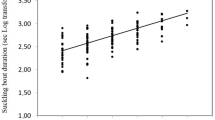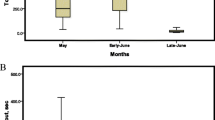Abstract
Calf suckling behaviour is a valid measure of maternal investment in the Saharan arrui, Ammotragus lervia sahariensis, since this variable is strongly correlated with the inter-birth interval. High-ranking females allocate their resources preferentially towards their sons, as the average suckling rate is significantly higher in male calves than in female calves during their 1st month of life, when maternal investment reaches the highest values of the whole lactation period. However, average suckling-bout duration shows no sex differences. Some maternal behaviours, such as sniffing and licking, are strongly correlated with suckling events. Only during the calves’ 1st week is the mother responsible for maintaining proximity; but from the following week on the calves are mainly responsible for maintaining it. In addition, when the calves are 1 month old, high-ranking females tend to maintain a stronger link with their male calves. Female calves spend more time with their mothers than male calves during their 1st month of life, if the mother’s rank is lower than 60%; otherwise, the opposite occurs, male calves being close to their mothers for longer, even from their 1st week of life. Finally, the higher the maternal rank the higher the proportion of male calves delivered.
Similar content being viewed by others
Author information
Authors and Affiliations
Additional information
Received: 18 April 1995/Accepted after revision: 11 February 1996
Rights and permissions
About this article
Cite this article
Cassinello, J. High-ranking females bias their investment in favour of male calves in captive Ammotragus lervia . Behav Ecol Sociobiol 38, 417–424 (1996). https://doi.org/10.1007/s002650050259
Issue Date:
DOI: https://doi.org/10.1007/s002650050259




